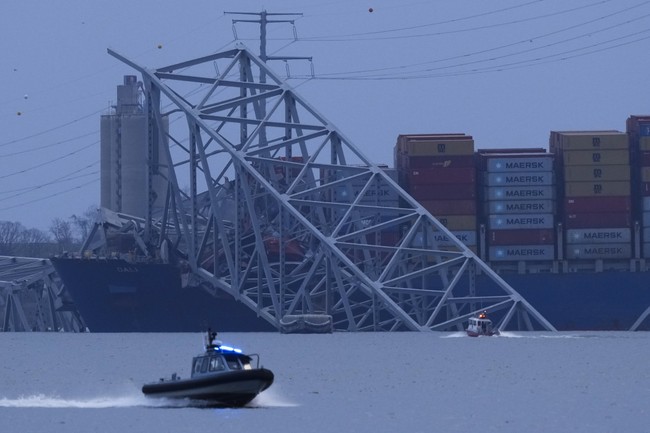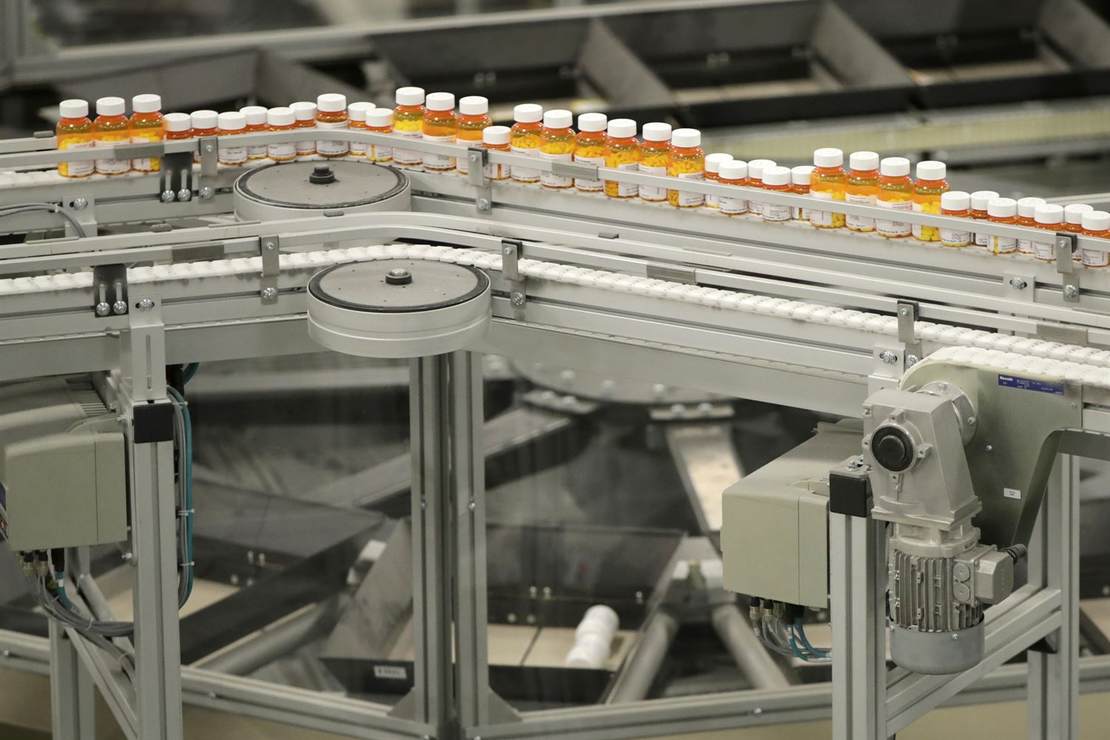
Alrighty. We are a full day removed from the God-awful tragedy of the container vessel Dali striking a pylon on the Francis Scott Key Bridge in Baltimore, sending the entire superstructure of the bridge into the mouth of the harbor, and the horrific loss of the construction workers who were still on the bridge when it went into the water.
Advertisement
The Coast Guard has officially called off the rescue search for those poor souls. God bless them and their families. It had been too long yesterday, and the water was just too cold.
The Coast Guard ended its search late Tuesday for six construction workers who were on a bridge in Baltimore when it was rammed by a massive cargo ship and collapsed into the Patapsco River.
“At this point, we do not believe we are going to find any of these individuals still alive,” Rear Adm. Shannon Gilreath said at a news conference just after dusk, citing the cold water temperatures and the length of time since the overnight collapse.
In a sad development late this afternoon, searchers announced they’d found two of the fellows in a submerged pickup truck.
A car containing the bodies of two construction workers was pulled from the Patapsco River Wednesday morning, shortly before Baltimore officials suspended search and recovery efforts for victims of the Francis Scott Key Bridge collapse disaster.
Divers located a red pick-up truck submerged 25 feet below the surface around 10 a.m. near the middle span of the bridge, Col. Roland L. Butler Jr., superintendent for Maryland State Police, said at a press conference.
The two victims were identified as 35-year-old Alejandro Hernandez Fuentes, who was from Mexico and lived in Baltimore, and Dorlian Ronial Castillo Cabrera, 26, who was from Guatemala and lived in Dundalk.
They will keep looking for their companion’s bodies.
It would most assuredly have been so much worse, but for the ship’s mayday call, which saved who knows how many lives. Officers were able to get to both sides of the bridge and stop traffic, but tragically, didn’t have enough time to get out to the guys working on the bridge.
Advertisement
Francis Scott Key bridge –
Audio of first responder call emerges – ‘the whole bridge just fell down’
A mayday call was issued by the cargo ship moments before officials decided to suspend traffic on both sides of the bridge. pic.twitter.com/KqkR1QyCun— BrownEyedGirl🇺🇸 (@BrownEyeGirl_45) March 27, 2024
With the harbor blocked by bridge debris and the grounded Dali herself, the Port of Baltimore is effectively shut down. This should help you visualize what the area looks lie.
Main terminal facilities in the Baltimore port complex. These facilities are currently inaccessible to maritime shipping services because of the collapse of the Francis Scott Key Bridge on March 26, 2024, when the containership MV Dali (10,000 TEU) collided with a bridge pier). pic.twitter.com/2EMC0aUzP9
— Jean-Paul Rodrigue (@ecojpr) March 27, 2024
Baltimore port officials are already scrambling to meet inquiries about diversions to other East Coast facilities. Economists who, meanwhile, have been taking first stock of the situation are making soothing noises.
…But port officials from New York to Georgia were busy on Tuesday fielding queries from shippers about diverting Baltimore-bound cargo from containers to vehicles and bulk material.
“We’re ready to help. We have ample capacity to absorb any surge in container traffic,” Port of Virginia spokesperson Joe Harris told Reuters.
The Norfolk-based port is seen as a major beneficiary, due to its close proximity to Baltimore, but ports in Savannah and Brunswick, Georgia, also were poised to absorb some traffic, a spokesperson for the Georgia Ports Authority said.
The situation is a marked shift from the clogged, understaffed ports and supply chain chaos of 2021 and 2022 that spiked prices and fueled inflation as Americans binged on imported goods purchases coming out of the COVID-19 pandemic.
East Coast ports have invested billions of dollars over the past decade to expand capacity and while the temporary closure at Baltimore may add time and cost for some companies, economists do not expect a significant macroeconomic impact.
Advertisement
Although I’m sure POTATUS and crew would be delighted to have something to blame inflation on.
Shipping companies, on the other hand, are putting the hammer down, and fast, invoking what’s known as “force majeure“. That’s a clause in contracts that relieves a party of contractual obligations if they’ve been prevented from fulfilling them because of a force beyond their control. Yes, they’re saying, we’ll dump your goods at the closest alternate point, but it’s on you, the goods owner, to take it from there even if delivery, etc, had been part of the contract.
Ocean carriers are declaring “force majeure” due to the Baltimore port bridge crisis, telling logistics companies and U.S. shippers including retailers that once cargo is dropped off at alternate ports, it becomes their responsibility to pick up.
In an alert to customers Tuesday, CMA CGM wrote, “Those (containers) on the water will be discharged at an alternate port where they will be made available for pick-up, and CMA CGM’s bill of lading will terminate.”
It was the first ocean carrier to declare force majeure — the provision in a contract that frees parties from an obligation due to events beyond their control.
COSCO announced Wednesday morning that its services would “be concluded” once the diverted container arrives at the alternate port. Evergreen announced the same measure.
At the moment, Maersk is still honoring transportation details in contracts.
How adroitly the port officials and shipping companies handle the change in plans will determine how big of an impact this closure is going to have. It can be a cluster of epic proportions or the ability of people to adapt and overcome may be a pleasant surprise. Before the accident, the Dali herself unloaded freight – which is still sitting at the docks – the likes of which might surprise you.
Advertisement
…Logistics executives tell CNBC the next 36 hours will be critical in the movement of the diverted trade away from the Port of Baltimore after the deadly accident of the 10,000-container capacity containership Dali crashed into the Francis Scott Key Bridge in the early hours of Tuesday.
According to ImportGenius, the Dali unloaded freight on March 24 which included clothing and household goods that could be on the diverted vessels, also ranged from approximately 80 containers of Satsuma mandarin oranges, approximately 74 containers of IKEA products and furniture to 104 containers of Electrolux products including chest freezers, air conditioners, and microwaves.
The Port of Baltimore is also No. 1 in the U.S for auto/light truck and agriculture tractor imports and exports.
…“The impact of the Baltimore port stoppage on construction and contractor supply chains may be significant,” said William George, director of research for ImportGenius.
Shipping companies also have to begin updating their port diversion notices immediately and in a more timely manner. It seems folks are already dialing in, worrying about where their shipment is headed, and for good reason. You have to have your transport locked on before your shipment arrives at wherever it’s going because you start getting charged late fees (detention and demurrage) if your container sits at the terminal and isn’t moved out almost right away. Those fees are outrageous.
There are also railway considerations, which were also a particular sticking point during COVID. Those haven’t yet returned to smooth sailing, either, and can gum up the works moving containers away from congested ports.
…CH Robinson expects rail services to return to Baltimore later this week, but Castle added, “Ocean containers headed to the port, primarily from Chicago, will pile up and not be able to move outbound for export.”
Val Noel, COO at TRAC Intermodal, the largest marine chassis provider and pool manager and a member of FLOW, tells CNBC the east-bound boxes out of Chicago, either export loads or revenue empties, will be held for a period of time at rail terminals in Chicago.
Officials from the DOT’s Office of Multimodal Freight told CNBC that FLOW is not yet capturing export cargo. However, the booking data it does have will be enable participants to see changes in trends relative to truck vs. rail bookings coming into the key impacted ports receiving the diverted trade.
One of the biggest concerns among logistics companies is availability of chassis for both truck and rail to handle the diverted cargo. Logistics managers have told CNBC the ports of Savannah, Brunswick, Virginia, Charleston, and New York/New Jersey are expected to be receiving the diverted freight. The ports tell CNBC they can receive the extra cargo, but logistics managers are concerned about the availability of chassis to receive the extra freight.
Advertisement
This is a hot mess, people, and there are only about a million moving pieces, every last one a vital cog.
Interestingly enough, Baltimore’s shutdown may have an effect on India’s power generation, as the port ships the bulk of its coal business to that country.
…The US exported about 74 million tons of coal last year, with Baltimore the second-largest terminal for the commodity. Plugging up a major coal hub threatens to disrupt global energy supply chains that have finally begun to work out the kinks left over from pandemic slowdowns.
…Baltimore ships less than 2% of global seaborne coal so the bridge collapse will have little effect on global prices, Thrasher said. He added that the coal that moves out of Baltimore includes a lot of India-bound thermal coal, which is used for electricity generation.
“It will cause some disruption or chaos from a supply-chain standpoint,” Thrasher said. “But the big question is the impact on India more than any global impact.”
A shutdown of Baltimore coal exports would affect a significant portion of the Indian coal supply. The country consumed about 91 million tons of coal last year, according to the Indian government, and Baltimore shipped about 12 million tons to India last year, according to a research note from analytics firm Energy Aspects. That means India gets roughly 13% of its coal through the Baltimore port.
Trucks coming into Baltimore will face a challenging rerouting. The Key bridge was their alternate route, as they aren’t allowed – for obvious reasons – in the tunnels.
…Matt Castle, VP for Global Forwarding at C.H. Robinson, explained to CNBC that there should be minimal delays for trucks coming into the port area from the north. “But for trucks coming into the area from the south, they’ll have to take the I-95 or I-895 tunnels or navigate around the harbor. That puts them closer to metro Baltimore and adds potentially an hour to their trips.”
Advertisement
For the workers at the port, that’s a whole ‘nuther story. As of right now, they have no port. Maryland lawmakers are drafting an emergency bill for income assistance.
Maryland lawmakers are drafting emergency legislation for income replacement to assist thousands of Port of Baltimore workers impacted by the Tuesday collapse of the Francis Scott Key Bridge.
…The Port of Baltimore is the ninth busiest port in the United States, according to census data, and handled more than $80 billion in import-exports in 2023, the most in 20 years. It is also home to Royal Caribbean, Carnival and Norwegian cruise lines.
Directly, the port supports 15,300 jobs, while another 140,000 in the area are related to port activities. The jobs provide a combined $3.3 billion in personal income, according to a CBS News report.
All vessel traffic in and out of the port was suspended in the wake of the collapse, but it will remain open for trucks. The Port of Baltimore said Tuesday that it is unclear how long ship traffic will be suspended.
Again, these are the preliminary assessments.
Working the kinks out and waiting to see what the economic impact is going to take time.
Unfortunately, it looks like there’s going to be plenty of time.



